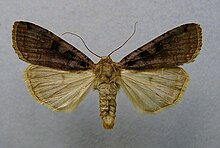| Xestia ditrapezium | |
|---|---|

| |
| Scientific classification | |
| Domain: | Eukaryota |
| Kingdom: | Animalia |
| Phylum: | Arthropoda |
| Class: | Insecta |
| Order: | Lepidoptera |
| Superfamily: | Noctuoidea |
| Family: | Noctuidae |
| Genus: | Xestia |
| Species: | X. ditrapezium
|
| Binomial name | |
| Xestia ditrapezium | |
| Synonyms | |
| |
Xestia ditrapezium (triple-spotted clay) is a moth of the family Noctuidae found in most of Europe, northern Turkey, northern Iran, Transcaucasia, Caucasus, central Asia, from the Altai to Ussuri, Amur, Kuril Islands, northern Mongolia, Tibet, China, Korea, and Japan.
The wingspan is 35–47 mm. The forewing is darker than in Xestia triangulum Hufn., a smooth vinous brown; the dark markings are not so black; the hindwing is distinctly yellowish-tinged.[1]
Differences from X. triangulum:
- X. ditrapezium forewings on average are narrower (or longer). The ground color of the forewings is usually darker (red to violet-brown) and the color of the rear wing is a shade lighter. The hindwings are significantly lighter than the forewings. The collar is without contrasts, almost monochrome.
- X. triangulum forewings on average are wider (or shorter). The ground color of the forewings is usually lighter (ochre to tawny or grayish brown); the color of the hindwings is usually slightly darker grey. The hindwings are about as light as the front wings. The lower part of the neck collar is grey, separated by a light line from the dark upper.
